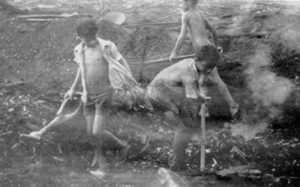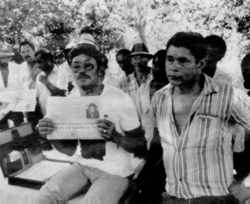
MARK EDWARDS / STILL
PICTURES
Gathering
strength
Which is the more Important question -
who does the
damage or what does the damage? David Ransom reaches
a
conclusion that will not please everyone.
Look at the balance sheet. Clearing the Amazon produces hardwoods which are essential for nothing. Dams flood the forest to generate electricity to make aluminium for throw-away cans. Iron ore is dug out of the ground to be sold at throwaway prices. Diseased cattle stroll about farting their greenhouse gases into the atmosphere to pander to a particular dietary preference in the cities. Rivers are polluted with deadly mercury to produce gold that is smuggled out through Uruguay to languish in the vaults of Swiss banks. The mass of the people of the Amazon are corralled into poverty, fearing for their lives. Indigenous people are persecuted to the verge of extinction. Can it really be for this that the greatest forest on earth is being made to disappear?
‘Well,’ says Philip Fearnside, one of the top scientific authorities on the Amazon, who works in Manaus, it’s a question of who is profiting. If that profit - and the costs - were evenly distributed, it wouldn’t be happening. The fact is that influential people are making money and the poor people out in the forest are paying the cost. It’s all perfectly logical from the point of view of the people who are making the money.’
Anthony Anderson, another American expert, who works for the Ford Foundation in Rio de Janeiro, makes a similar point. ‘Ranchers can’t have an environmental ethnic’, he says. ‘The key to environmental conservation in countries where the majority of people are poor is to engage them. They have a pretty innate sense that the forest is where their livelihoods remain.’
But it is the ranchers and their like who rule Brazil. There are, it seems to me, just two simple reasons why they do. The first is that when real political change - and agrarian reform in particular -last threatened to become a serious possibility there was a military coup. For 20 years after 1964 the country descended into a reign of official terror from which the people of Brazil have yet to recover fully.
It was the military dictatorship that launched the modern invasion of the Amazon. They built the roads and reinforced the network of cronyism from which the destroyers of the Amazon feed. To avoid political and social change they ‘colonized’ the rainforest: ‘A land without people for people without land’ was how the well-worn phrase went. In the process, oblivious of the people who actually did live in the Amazon, and in pursuit of grandiose ‘strategic’ objectives of the kind that appeal to the military mind, they saddled the people of Brazil with a foreign debt of quite astronomic proportions.
This brings me to the second reason why the ranchers and their like still rule Brazil. Quite simply it suits their creditors. The military coup of 1964 was backed directly by the US and tacitly by everyone else with a vested interest in the country. Today their priority is the repayment of the Brazilian foreign debt, not the preservation of the Amazon. The issue isn’t that the destruction of the rainforest brings in lots of foreign currency with which to pay back the debt. It doesn’t. More to the point is that real political change might lead to the renunciation of debt by people who feel, quite rightly, that they never signed the contract or benefited from its bounty.
So the Amazon is made to serve as a social ‘safety valve’, a sort of slush fund to keep the power brokers happy and the principle of debt repayment intact. What’s so daft and almost pathologically criminal about it is that Brazil’s creditors are in practice writing the debt off as fast as they can.
And, sadly enough, the international agencies that should know better are toeing the same line. Just about every expert on rainforests I talked to reserved their most virulent attacks for the United Nation’s Food and Agricultural Organization (FAO). It is the ‘lead’ organization in what is known as the Tropical Forestry Action Plan, which rides on the back of environmental concern while in practice promoting the interests of industrial forestry and forest-based industries.’
It would be easy and possibly quite true to say that deforestation could be stopped tomorrow if a) Brazil’s foreign debt were written off b) there were agrarian reform and c) cattle ranching, logging and mining were no longer promoted by the Government and international agencies alike. End of argument.
 Photo: David Ransom |
The trouble is that no-one I met seriously believes that any of this is likely to happen tomorrow, or even the day after. And make no mistake, the situation of the people of the Amazon is deteriorating as fast as that of the rainforest itself - if not faster. So you have to try to puzzle out what might reasonably be done in the meantime. And that is precisely what many Brazilians have already been doing for some time.
I am told that there are upwards of 2,000 ‘non-governmental organizations’ (NGOs) at work in the Amazon. That might mean anything. But what is not really in doubt, I think, is that the unrest that began in the late 1970s marked a turning point not just for the military dictatorship but for many of the individual people and groups I spoke to as well.
Claudia Andrujar escaped from Hungary with her mother during the Second World War. The rest of her family did not survive. ‘I somehow always felt that I too was one of the people who had been condemned to disappear,’ she says.
She finally settled in Brazil and began a successful career as a professional photographer. By the mid-1970s she was beginning to tire of commercial photographic assignments. She took time out and went off to study the Yanomami Indians on the border between Brazil and Venezuela. She was to spend some six years living with them. ‘I saw disease arriving with the road. The people were totally unprepared. Then came the garimpeiros, the gold panners. I was there, witnessing the death of the people and trying to do something to help them survive.’
Expelled from the area by the Government, she launched a campaign in São Paulo to create a Yanomami Park. When I met her she had just returned from meeting the Minister of Justice, Jarbas Passarinho (‘Little Bird’). He is a military man, the link between the civilian Government of President Collor and the military establishment.
‘I asked him: “Well, what do you think? How are you going to help the Yanomami people?” He said: “You know, there’s an awful lot of opposition to the creation of the Park.” He talked a lot about “geopolitical considerations”. I’ve heard this kind of talk since the 1970s and I thought they’d got over it. I thought President Collor wanted to change the image of, well, the word ‘genocide’ has been used even here in Brazil. But at the moment he is not in a position to oppose the military ...'
People like Claudia are clearly doing much to try and bring about change from within Brazil. But what can people outside the country do? ‘The most important thing you can do,’ says Claudia, ‘is to be willing to learn more and understand the problem, because it is only through understanding that you will find out what has to be done.’
When I set out on this trip I was Anxious to discover a model of ‘sustainable’ development, a way of protecting the forest while improving the lives of the people, that we might all (smugly?) subscribe to. What I actually found out is that no such model yet exists. The best that experts can provide for us is some kind of ‘goal’, a framework of values yet to be filled with knowledge and experience.
Consider this. Everywhere in the Amazon the destruction of the forest has followed the building of roads. The BR 364 has ripped through Rondônia and there are plans to drive it on through Acre to Peru and the Pacific, opening the veins of the Amazon to the thirst of the Japanese for hardwoods and raw materials. José Lutzemburger, the celebrated environmentalist who is now Brazil’s Minister for the Environment, has gone on record to say that the road will not go through. Surely, I thought, any self-respecting environmentalist must welcome this.
But no-one I spoke to in Acre either believes or agrees with it. ‘There’s nothing wrong with roads, you know’, Macedo said to me. ‘It’s who and what they are used for that matters.’
I think he’s right. You can’t condemn the people of Acre to live forever in the nineteenth century. If you do they will simply leave the forest and there will be no-one to protect it. Banning roads in the Amazon doesn’t quench the rich world’s thirst for drugs and hardwoods, bring about agrarian reform or tackle the gross injustice of Brazilian society.
Again, the thickest smoke over the poorest part of Paragominas comes from the top of a hill. Fully prepared for yet another mental condemnation of the patrões, what I actually found was a ragged-trousered collective of very poor people using the waste wood left by the sawmills to make charcoal. The operation was overseen by an old, tough, black woman wearing a baseball hat.
Should I applaud the collective or condemn the destruction? Close down the charcoal collective and you have a dozen or more destitute families ready to cut down the forest instead - and the wood still goes to waste. The point is that simple, sure-fire prohibitions in response to complex human situations can lead us to false conclusions that may actually make things worse.
Many of the people I met were very anxious indeed to develop markets for ‘sustainable’ products that don’t damage the forest - and, above all, that can provide a decent income. Brazil nuts are one of the most important of these. So yes, go out and buy as many as you can from the co-operatives that produce them in Extractive Reserves. That means finding out about your nearest ‘alternative traders’ who take a detailed interest in how the products they sell are produced and buying from them, not from the supermarket.
The point is that in the process you have taken an active interest in what is going on - become ‘engaged’. And that is what everyone I met in the Amazon, without exception, wants you to do. You might go on from there to support an immediate ban on the trade in tropical hardwoods, which is urgently needed, or seek out beautiful Kampa handicrafts when and if they reach the market. And you might go on from that to wonder why your own government may be supporting the status quo in Brazil and demanding the blood of the Amazon in payment of its ill-gotten debts.
There would then, I think, be no shortage of obvious things for you to do, or of reasons for doing them. In supporting, say, groups that work for human rights and land reform in Latin America you would also be engaged in the struggle to save the Amazon forest, in bringing rich world concern with the environment together with Third World concern for human life.
For myself, I shall not forget sitting, tired, hot and hungry, in the middle of a babassu palm grove on land still owned by former President Sarney, one of the biggest landowners in Maranhão. Around me were people who had ‘invaded’ it, talking about the violence they had endured and what they need now. Rather timidly I asked whether Brazil might one day be run, not by the hated patrões and fazendeiros, but by them. There was a pause. ‘Yes!’ said the woman sitting next to me. Suddenly, quite unexpectedly, she smiled. Then everyone burst into laughter and applause.
1 See, for example, Larry Lohmann and Marcus Coichester, ‘Paved with Good Intentions’ in The Ecologist. May/June 1990.

Organized crime: Almir Santos, a leader of landless squatters in the ‘Parrot’s Beak’, displays a newspaper picture of Sebastião Teresona. Teresona has been arrested and charged with the murder of dozens of squatters in the State of Pará. The squatters say that Teresona is a pistolero (gunman) hired by local fazendeiros (ranchers) for $20 a killing. He is missing one finger on his right hand, which the squatters say was cut off with a machete by one of his victims before his death. People at the meeting come forward with horrific details of friends and relatives who have been murdered, homes cut in half with chain saws, crops burned just before harvest time: ‘The men who kill the forest are the ones who kill the people’ they say.
Story Herbert Girardet; Photo Mark Edwards / STILL PICTURES
Worth
reading on... THE AMAZON
By far the most interesting and
convincing recent work on the Amazon is S Hecht and A Cockburn The Fate of
the Forest (Verso 1989, also available in Penguin 1990). Lighter and
eccentric travelogues are Redmond O'Hanlon In Trouble Again (Penguin
1989) and Stephen Nugent Big Mouth - the Amazon Speaks (Fourth Estate
1990). But I'm not sure they improve much on Henry W Bates' classic The
Naturalist on the River Amazon, first published in 1864 (reprinted by John
Murray, 1964) - it's worth taking the trouble to find this one. On the
indigenous peoples, John Hemming's Amazon Frontier: the Defeat of the
Brazilian Indians (Macmillan 1987) is thorough, readable if a bit dense. For
anyone interested in going more deeply into the environmental issues, try
Anthony B Anderson Alternatives to Deforestation (Colomnia University
Press 1990) or (deeper still) Ghillean Prance and Thomas Lovejoy Key
Environmentalists: Amazonia (Pergamon 1985) though you'll need about $60 to
buy it if you can't get it from a library.
For a quick and informative read that deals with most of the important issues in a crisp fashion you can't do better than Fight for the Forest: Chico Mendes in his Own Words (Latin America Bureau 1989), and on land rights read Sue Branford and Oriana Glock, The Last Frontier: Fighting Over Land in the Amazon (Zed Press 1985). For an up-to-date account of Brazil covering some of the same places and issues as this magazine order Neil Macdonald's Brazil - A Mask Called Progress from Oxfam Publications, PO Box 120, Oxford OX2 7DZ, UK, price £4.95.
![]()
| BRAZIL: |
União das Nações Indigenas (UNI) (Union of Indigenous Nations): Ailton Krenak, National Co-ordinator, Praqa Enio Barbato s/n, 05.517 São Paulo, SR Movimento de Muiheres do Campo e da Cidade (Movement of Rural and Urban Women): Rua Manoel Barata 47, sala 305, Centro, 66.020 Belém, PA. Comissão pela Criação do Parque Yanomami (Commission for the Creation of the Yanomami Park): Claudia Andrujar, Rua Manoel da Nobrega 111, 3 andar, cj 32, 04.001 São Paulo, SP. FASE (Federation of Organizations for Social and Educational Assistance), Rua Bento Lisboa, 58, 22.227 Rio do Janeiro, RJ. Conselho Nacional Dos Seringuieros (National Council of Rubber Tappers), Rua Guanabara 150, Estação Experimental, 69.900 Rio Branco, AC. Upper Juruá Valley Extractive Reserve: fundraising and support for the Co-operative Association is being co-ordinated by The Gaia Foundation, 18 Well Walk, London NW3 1LD.
Two important national organizations that can put you in touch with others (and can usually answer queries in English) are: IBASE, Rua Vicente do Souza, 29, Botafogo, 22.251 Rio do Janeiro, RJ. CEDI, Av Higienópolis 983, 01.238 São Paulo, SP.
| AOTEAROA (New Zealand): |
Maruia Society, Box 756 Nelson.
Pacific Institute of
Resource Management, Box 10123 Wellington.
| AUSTRALIA: |
Australian Conservation Foundation, 340 Gore St, Fitzroy,
Vic. 3065.
Greenpeace, 37 Nicholson Road, Balmain, NSW 2041.
| CANADA: |
Friends of the Rainforest, Box 4612, Ste E, Ottowa, Ont K15
5H8.
Western Wilderness Committee, 20 Water St, Vancouver, BCV6B 1A4.
Probe International, 225 Brunswick Aye, Toronto, Ont M55 2M6.
| UK: |
Survival International, 6 Charterhouse Buildings LONDON
EC1M 7ET
Tel: +44 (0)20 7687 8700. Fax: +44 (0)20 7687 8701
E-mail: info@survival-international.org
Web: http://www.survival-international.org/
Amnesty International, 1 Easton Street, London WC1X 8DJ.
Minewatch, 218 Liverpool Road, London Ni iLE.
Oxfam UK,
274 Banbury Road, Oxford 0X2 7DZ.
| US: |
Rainforest Action Network, 301 Broadway, Suite A, San
Francisco CA 94133.
Environmental Defense Fund, 1616 P St, NW,
Washington DC 20010.



